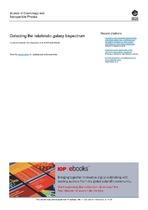| dc.contributor.author | Maartens, Roy | |
| dc.contributor.author | Jolicoeur, Sheean | |
| dc.contributor.author | Umeh, Obinna | |
| dc.date.accessioned | 2021-02-18T11:16:37Z | |
| dc.date.available | 2021-02-18T11:16:37Z | |
| dc.date.issued | 2020 | |
| dc.identifier.citation | Maartens, R. et al. (2020). Detecting the relativistic galaxy bispectrum. Journal of Cosmology and Astroparticle Physics, 2020(03) | en_US |
| dc.identifier.uri | 10.1088/1475-7516/2020/03/065 | |
| dc.identifier.uri | http://hdl.handle.net/10566/5957 | |
| dc.description.abstract | The Fourier galaxy bispectrum is complex, with the imaginary part arising from
leading-order relativistic corrections, due to Doppler, gravitational redshift and related lineof-sight effects in redshift space. The detection of the imaginary part of the bispectrum is
potentially a smoking gun signal of relativistic contributions. We investigate whether nextgeneration spectroscopic surveys could make such a detection. For a Stage IV spectroscopic
Hα survey similar to Euclid, we find that the cumulative signal to noise of this relativistic
signature is O(10). Long-mode relativistic effects couple to short-mode Newtonian effects
in the galaxy bispectrum, but not in the galaxy power spectrum. This is the basis for
detectability of relativistic effects in the bispectrum of a single galaxy survey, whereas the
power spectrum requires multiple galaxy surveys to detect the corresponding signal. | en_US |
| dc.language.iso | en | en_US |
| dc.publisher | IOP Publishing Ltd | en_US |
| dc.subject | Cosmological parameters from LSS | en_US |
| dc.subject | Cosmological perturbation theory | en_US |
| dc.subject | Redshift surveys | en_US |
| dc.subject | Galaxy bispectrum | en_US |
| dc.subject | Relativistic | en_US |
| dc.title | Detecting the relativistic galaxy bispectrum | en_US |
| dc.type | Article | en_US |

